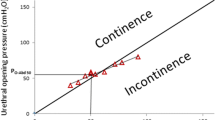Abstract
A prospective observational study was conducted in a tertiary urogynaecology unit in women with the primary symptom of urinary incontinence to assess the repeatability of the 24-hour pad test. One hundred and eight women undertook seven 24-hour pad tests over 7 consecutive days together with 7 simultaneous fluid and activity charts. The results were analysed collectively and according to urodynamic subsets. Repeatability was assessed by repeated measures analysis of variance and univariate analysis of variance for each urodynamic diagnosis group (USI, mixed and no USI). Variation between pad test weights over the 7 days was low, supporting good repeatability. The number of days of pad testing required to approximate the 7-day average was 3 days. However, a single 24-hour pad test correlated highly with the 7-day average (r=0.881) and was considered sufficient to gauge leakage severity.





Similar content being viewed by others
References
Lose G, Fantl JA, Victor A, Walter S, Wells TL, Wyman J et al (1998) Outcome measures for research in adult women with symptoms of lower urinary tract dysfunction. Neurourol Urodyn 17:255–262
Sutherst J, Brown M, Shawer M (1981) Assessing the severity of urinary incontinence in women by weighing perineal pads. Lancet 1:1128–1130
Mouritsen L, Berild G, Hertz J (1989) Comparison of different methods for quantification of urinary leakage in incontinent women. Neurourol Urodynam 8:579–587
Abrams P, Blaivas JG, Stanton SL, Andersen JT (1988) The standardisation of terminology of lower urinary tract function. The International Continence Society Committee on Standardisation of Terminology. Scand J Urol Nephrol Suppl 114:5–19
Simons AM, Yoong WC, Buckland S, Moore KH (2001) Inadequate repeatability of the one-hour pad test: the need for a new incontinence outcome measure. BJOG 108:315–319
Jakobsen H, Kromann-Andersen B, Nielsen KK, Maegaard E (1993) Pad weighing tests with 50% or 75% bladder filling. Does it matter? Acta Obstet Gynecol Scand 72:377–381
Fantl JA, Harkins SW, Wyman JF, Choi SC, Taylor JR (1987) Fluid loss quantitation test in women with urinary incontinence: a test-retest analysis. Obstet Gynecol 70:739–743
Moore KH, O’Sullivan RJ, Simons A, Prashar S, Anderson P, Louey M (2003) Randomised controlled trial of nurse continence advisor therapy compared with standard urogynaecology regimen for conservative incontinence treatment: efficacy, costs and two year follow up. BJOG 110:649–657
Groutz A, Blaivas JG, Chaikin DC, Resnick NM, Engleman K, Anzalone D et al (2000) Noninvasive outcome measures of urinary incontinence and lower urinary tract symptoms: a multicenter study of micturition diary and pad tests. J Urol 164:698–701
Rasmussen A, Mouritsen L, Dalgaard A, Frimodt-Moller C (1994) Twenty-four hour pad weighing test: reproducibility and dependency of activity level and fluid intake. Neurourol Urodyn 13:261–265
Versi E, Orrego G, Hardy E, Seddon G, Smith P, Anand D (1996) Evaluation of the home pad test in the investigation of female urinary incontinence. Br J Obstet Gynaecol 103:162–167; comment 720
Lose G, Jorgensen L, Thunedborg P (1989) 24-hour home pad weighing test versus 1-hour ward test in the assessment of mild stress incontinence. Acta Obstet Gynecol Scand 68:211–215
O’Sullivan R, Yoong W, Allen W, Buckland S, Moore K (2000) The repeatability and definition of mild, moderate and severe on the 24 hour pad test in 96 incontinent women. Neurourol Urodyn 19:480–481
Schafer W, Abrams P, Liao L, Mattiasson A, Pesce F, Spangberg A et al (2002) Good urodynamic practices: uroflowmetry, filling cystometry, and pressure-flow studies. Neurourol Urodyn 21:261–274
Abrams P, Cardozo L, Fall M, Griffiths D, Rosier P, Ulmsten U et al (2002) The standardisation of terminology of lower urinary tract function: report from the Standardisation Sub-committee of the International Continence Society. Am J Obstet Gynecol 187:116–126
Altman DG (1995) Practical statistics for medical research. Chapman and Hall, London
Author information
Authors and Affiliations
Corresponding author
Additional information
Editorial Comment: The authors examine the repeatability of the 24-hour pad test through a well-designed study. Through the appropriate use of statistical methodology, they answer several important research questions regarding this diagnostic tool. They conclude that the 24-hour pad test is adequate to predict the results of 7-day pad tests. There is very little variability among the consecutive days. Three days is the number of days required to approximate the 7-day average. In order to identify the validity of the pad test as a medical test, we need to extend the work of the authors to answer future research questions, such as: do one or three 24-hour pad tests predict the results of other diagnostic tools available to us? These would include patient’s symptoms collected by direct interview or by the use of a validated questionnaire, urodynamic studies and a cough stress test
Rights and permissions
About this article
Cite this article
Karantanis, E., Allen, W., Stevermuer, T.L. et al. The repeatability of the 24-hour pad test. Int Urogynecol J 16, 63–68 (2005). https://doi.org/10.1007/s00192-004-1199-8
Received:
Accepted:
Published:
Issue Date:
DOI: https://doi.org/10.1007/s00192-004-1199-8




